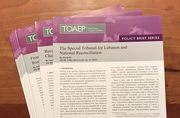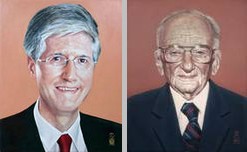Table of contents:
P.23. Evidence inferred from a circumstance.
P.23.1. Evidence of prisoner(s) of war.
P.23.2. Evidence of prisoner(s) of war held in detention.
P.23.3. Evidence of person or persons parachuted in a hostile territory.
P.23.4. Evidence of soldiers on leave.
P.23.5. Evidence of soldiers surprised in their sleep by the adversary.
P.23.6. Evidence of person or persons not a part of the army / ready for combat.
P.23.7. Evidence that such person or persons laid down their arms and raised their hands.
P.23.10. Evidence of ceasing fire and lowering the flag.
P.23.11. Evidence of the crew boarding lifeboats.
P.23.12. Evidence of issuing signals.
P.23.13. Evidence of a white flag.
P.23.15. Evidence of shipwrecked persons.
P.23.16. Evidence of wounded person or persons.
Element:
A. Evidentiary comment:
This specific mental element distinguishes this offence from the killing or injuring that can occur as a consequence of an attack that was not aiming at persons hors de combat. Michael Cottier remarks that "the attacking combatant must base his attack on information reasonably available to him at the time [ ] [i]f it is clear to a combatant that the person before him has no more means of fight or defense, he may not attack and kill or wound this person and must presume a willingness to surrender at discretion". However, this does not imply "the requirement of a particular signal of surrender when it [is] obvious to the attackers that the persons aimed at were hors de combat [ ].[Indeed,] articles 41 and 85 para.3 (e) First Add. Prot. require only a knowledge that the attacked person is hors de combat, thus is either in the power of the enemy, has laid down his arms or expresses an intention to surrender." (Michael Cottier, "Article 8" in Otto Triffterer, ed, Commentary on the Rome Statute of the International Criminal Court (1999) article 8, paras. 66 and 67).
P.23. Evidence inferred from a circumstance.
P.23.1. Evidence of prisoner(s) of war.
Trial of Gunther Thiele and Georg Steinert, LRTWC, UNWCC, Volume III, p.56:
"It was shown that a United States officer was wounded and taken prisoner by members of the command of Lieutenant Thiele. Captain Schwaben, the battalion commander and superior officer of Lieutenant Thiele, sent an order to Lieutenant Thiele to kill the prisoner. [ ]"
The Essen Lynching case, LRTWC, UNWCC, Volume I, p. 88:
"Heyer, a Captain in the German Army, gave instructions that a party of three Allied prisoners of war were to be taken to a Luftwaffe unit for interrogation. He ordered the escort not to interfere if civilians should molest the prisoners, while also saying that they ought to be shot, or would be shot. A German private was charged with having refrained from interfering with a crowd which murdered the prisoners, although entrusted with their custody. The remaining accused were German civilians who were alleged to have committed the killing. Heyer and one civilian were sentenced to death. The private and two further civilians were sentenced to terms of imprisonment. The remaining two civilians were acquitted."
P.23.2. Evidence of prisoner(s) of war held in detention.
A. Legal source/authority and evidence:
Prosecutor v Milomir Stakić, Case No. IT-97-24-T, Judgment (TC), 31 July 2003, paras. 193 and 589:
"193. Slobodan Kuruzovic objected to the characterisation of the Trnopolje camp in several documents as a "prisoner of war camp". 394 He said that nobody in Trnopolje was interrogated and that the detainees had complete freedom of movement. In the light of overwhelming evidence to the contrary, the Trial Chamber is not convinced by this testimony."
"394. Slobodan Kuruzovic, T. 14781."
"589. The Trial Chamber is convinced that the vast majority of the victims of these crimes were taking no active part in the hostilities at the time the crimes were committed. In particular, the Trial Chamber finds that those held in the Omarska, Keraterm and Trnopolje camps are automatically to be considered hors de combat by virtue of their being held in detention. [ ]."
Prosecutor v. Mladen Naletilić and Vinko Martinović, Case No. IT-98-34-T, Judgement (TC), 31 March 2003, para. 238:
"238. [ ] Detained BH Muslim civilians and BH Muslim soldiers hors de combat were often subjected to humiliating and brutal mistreatment by soldiers who had unfettered access to the detention facilities."
P.23.3. Evidence of person or persons parachuted in a hostile territory.
A. Legal source/authority and evidence:
Trial of Peter Back, LRTWC, UNWCC, Vol. III, p. 60:
"It was charged that Peter Back, a German civilian, "did, at or near Preist, Germany, on or about 15th August, 1944, violate the laws and usages of war by wilfully, deliberately and feloniously killing an American airman, name and rank unknown, a member of the Allied Forces, who had parachuted to earth at said time and place in hostile territory and was then without any means of defence.""
P.23.4. Evidence of soldiers on leave.
A. Legal source/authority and evidence:
Prosecutor v. Tihomir Blakić, Case No. IT-95-14-T, Judgement (TC), 3 March 2000, para. 405:
"405. General Blaskic claimed that, in the night of 15 to 16 April, HVO members informed him that soldiers from the first and seventh brigades of the ABiH were coming towards Vitez by truck. These were soldiers going home on leave to Krusica and Ahmici. The HVO maintained that those soldiers were drunk and excited. There again, that information was not enough to justify the attack. On the contrary, it highlighted the fact that the soldiers were on leave and were not preparing to fight in the municipality of Vitez."
P.23.5. Evidence of soldiers surprised in their sleep by the adversary.
A. Legal source/authority and evidence:
Michael Cottier in Triffterer (ed.), Commentary on the Rome Statute of the International Criminal Court, article 8, para. 1614 :
"The same [protection under article 41 of the First Additional Protocol] applies to an unarmed soldier, whether he is surprised in his sleep by the adversary, on leave or in any other similar situation. Obviously, the safeguard only applies as long as the person concerned abstains from any hostile act and does not attempt to escape".
P.23.6. Evidence of person or persons not a part of the army / ready for combat.
A. Legal source/authority and evidence:
Prosecutor v. Tihomir Blakić, Case No. IT-95-14-T, Judgement (TC), 3 March 2000, para. 407:
"407. The Trial Chamber also notes that much of the evidence contradicted the Defence submission that the ABiH forces were preparing for combat. Witness Abdullah Ahmic, inter alia, described the armed Muslim units present in the Ahmici area in April 1993 to the Trial Chamber. According to his testimony, the territorial defence was starting to organise in the area and consisted of about 120 men whose main task was to carry out night watches. According to that witness, their participation was purely voluntary and there was no disciplinary sanction for those who failed to take their turn on guard. It was therefore a sort of civil defence rather than an army strictly speaking. The members of the territorial defence were very badly equipped and most of them were dressed as civilians and did not think of themselves as soldiers. There was no barracks in Ahmici. Witness Hadzihasanovic confirmed this information, stating that owing to the lack of men and of equipment, and in particular of barracks, the only armed presence in the village of Ahmici and those nearby was a territorial defence unit from Zenica in case of a Serb parachute attack. [ ]"
P.23.7. Evidence that such person or persons laid down their arms and raised their hands.
A. Legal source/authority and evidence:
J. de Preux, Commentary on the Additional Protocols of 8 June 1977 to the Geneva Conventions of 12 August 1949, para 1618:
"In land warfare, surrender is not bound by strict formalities. In general, a soldier who wishes to indicate that he is no longer capable of engaging in combat, or that he intends to cease combat, lays down his arms and raises his hands. Another way is to cease fire, wave a white flag and emerge from a shelter with hands raised."
A. Legal source/authority and evidence:
J. de Preux, Commentary on the Additional Protocols of 8 June 1977 to the Geneva Conventions of 12 August 1949, para. 1618:
"In land warfare, surrender is not bound by strict formalities. In general, a soldier who wishes to indicate that he is no longer capable of engaging in combat, or that he intends to cease combat, lays down his arms and raises his hands. Another way is to cease fire, wave a white flag and emerge from a shelter with hands raised."
A. Legal source/authority and evidence:
J. de Preux, Commentary on the Additional Protocols of 8 June 1977 to the Geneva Conventions of 12 August 1949, para. 1619:
"In the air, it is generally accepted that a crew wishing to indicate their intention to cease combat should do so by waggling the wings while opening the cockpit (if this is possible)26. [ ] These measures can be supplemented by radio signals transmitted on international frequencies for callsigns. No argument of military necessity may be invoked to refuse an unconditional surrender."
"26F. Berber, op. cit., p. 168, and F.A. von der Heydte, op. cit., p. 7. The intention to obey an order to land is indicated by lowering the landing gear."
P.23.10. Evidence of ceasing fire and lowering the flag.
A. Legal source/authority and evidence:
J. de Preux, Commentary on the Additional Protocols of 8 June 1977 to the Geneva Conventions of 12 August 1949, para. 1619:
"[ ] At sea, fire should cease and the flag should be lowered.27 These measures can be supplemented by radio signals transmitted on international frequencies for callsigns. No argument of military necessity may be invoked to refuse an unconditional surrender."
"27 Some consider that it is also necessary to stop the engines, reply to the signals of the captor, abstain from handling weapons and raise the while flag (or put on lights at night) (see "Trial of Helmut von Ruchteschell", 9 Law Reports, p. 89). "
Trial of Helmuth Von Ruchteschell, LRTWC, UNWCC, Vol. IX, p. 89:
"[ ] The question, however, on which there is remarkably little authority is what constitutes unconditional surrender at sea. As soon as an attacked or counter-attacked vessel and her crew hauls down her flag and therefore signals that she is ready to surrender, she must be given quarter and seized without further firing. To continue to attack, though she is ready to surrender and to sink the vessel and her crew would constitute a violation of customary international law and would only as an exception be admissible in case of imperative necessity or of reprisals. [ ]
P.23.11. Evidence of the crew boarding lifeboats.
P.23.12. Evidence of issuing signals.
P.23.13. Evidence of a white flag.
A. Legal source/authority and evidence:
Trial of Helmuth Von Ruchteschell, LRTWC, UNWCC, Vol. IX, p. 89:
"[ ] Two experts witnesses (a captain in the Royal Navy and a former vice-admiral in the German Navy) gave evidence, inter alia, on the customs in this regard of their respective services. The common denominator of their evidence could be thus stated: (1) the attacked ship must stop their engines; (2) if the attacker signals, the signal must be answered- if the wireless is out of action, it must be answered by a signalling pennant by say or by a torch or flashing by night; (3) the guns must not be manned, the crew should be amidships and taking to the lifeboats; (4) the white flag may be hoisted by day and by night, all the ships lights should be put on. (1)
[ ] The Judge Advocate in his summing up said that stopping the ship and the ship and switching on navigation lights, masthead lights and deck lights is an unequivocal indication of surrender. He also advised the Court that if the accused deliberately or recklessly prevented the attack ship from surrendering by making it impossible for her to convey her readiness to surrender, he would be guilty of a violation of customary rules of sea warfare."
"(1) It was held by the Privy Council in the case of the "Pellworm" (1922 A.C. 292) that hauling down the flag alone is not sufficient indication of surrender if it is accompanied by a change of course. The Privy Council held that "in principle capture consists of compelling the captured vessel to conform to the captors will. When that is done "Deditio" is complete. The conduct necessary to establish the fact of capture may take many forms. No particular formality is necessary."
P.23.15. Evidence of shipwrecked persons.
A. Legal source/authority and evidence:
The Peleus Trial, Trial of Kapit?nleutnant Heinz Eck and Four Others for the Killing of Members of the Crew of the Greek Steamship Peleus, Sunk on the High Seas, LRTWC, UNWCC, Vol. I, 1947, p.3:
"On the 13th March, 1944, the ship was sunk in the middle of the Atlantic Ocean by the German submarine No. 852, commanded by the first accused, Heinz Eck. Apparently the majority of the members of the crew of the "Peleus" got into the water and reached two rafts and wreckage that was floating about. [ ]. The submarine then proceeded to open fire with a machine-gun or machine-guns on the survivors in the water and on the rafts, and also threw hand grenades on the survivors, with the result that all of the crew in the water were killed or died of their wounds, except for three [ ]."
P.23.16. Evidence of wounded person or persons.
P.23.17. Evidence of sick person or persons.
A. Legal source/authority and evidence:
J. de Preux, Commentary on the Additional Protocols of 8 June 1977 to the Geneva Conventions of 12 August 1949, para. 1620:
"The wounded and sick in the sense of Article 8 (Terminology), sub-paragraph (a), of the Protocol, are those persons who need medical care as a result of a trauma, disease or other physical or mental disorder or disability, and who refrain from any act of hostility.[ ] [I]t is the wound or the sickness, the unconscious [ ] in short, the fact of being struck down, of having given up which in this case forms the basis of the obligation. In fact it is not because a person of the adverse Party is wounded, or partially handicapped, that this obligation arises, but because he is incapable of defending himself.[ ] On the other hand there is no obligation to abstain from from attacking a wounded or sick person who is preparing to fire, or who is actually firing, regardless of the severity of his wounds or sickness".







